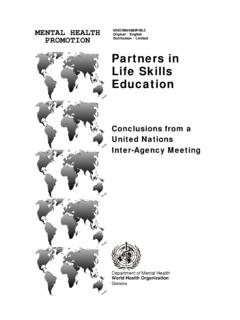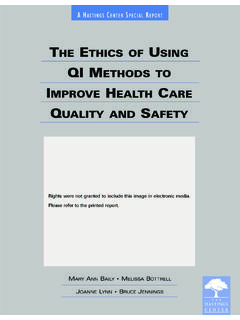Transcription of The World Health Organization’s
1 The World Health organization sINFORMATION SERIES ON SCHOOL HEALTHDOCUMENT 10 Creating anEnvironment forEmotional andSocial Well-BeingAn important responsibility of a Health -Promotingand Child Friendly SchoolWHO gratefully acknowledges the generous financial contributions to supportthe development, layout and printing of this document from: the Division ofAdolescent and School Health , National Center for Chronic Disease Preventionand Health Promotion, Centers for Disease Control and Prevention, Atlanta,Georgia, principles and policies of each of the above agencies are governed by the relevant decisions of itsgoverning body and each agency implements the interventions described in this document in accordance with these principles and policies and within the scope of its BANKWHOUNICEFiiWHO INFORMATION SERIES ON SCHOOL HEALTHM aterial herein was originally prepared by Professor Suzanne Skevington, WHOC onsultant to the team in Mental Health Promotion and Policy, August/September 1999with assistance from Mamata Puitandy.
2 And was originally titled "Child Friendly SchoolsChecklist". Isolde Birdthistle prepared this document for the Department of NoncommunicableDisease Prevention and Health Promotion and the Department of Mental Health andSubstance Dependence, WHO, by updating, revising and supplementing the content ofthe original document. Jack T. Jones, Department of Noncommunicable Disease Prevention and HealthPromotion, School Health and Youth Health Promotion and Shekhar Saxena, Departmentof Mental Health and Substance Dependence served as Project Officers for the revisionand completion of this copies of this document may be obtained from the Department of Noncommunicable Disease Prevention and Health Promotion or the Department ofMental Health and substance Dependence, Evidence and Research.
3 World Health Organization1211 Geneva 27 SwitzerlandWHO would like to thank the following individuals who offered substantial comments andsuggestions during the document s revision and finalization:This document is not a formal publication of the World Health organization (WHO). However, all rights arereserved by the organization . The document may be freely reviewed, but is not for sale or for use in conjunctionwith commercial BelferMental Health and SubstanceDependenceWorld Health OrganizationGeneva, SwitzerlandMagdalena CerdaInjuries and Violence PreventionWorld Health OrganizationGeneva, SwitzerlandMary Joy PigozziDivision for the Promotion of QualityEducationUNESCOP aris, FranceMichel JonoszUniversity of MontrealMontreal, CanadaSuzanne SkevingtonDepartment of PsychologyUniversity of BathBath, United KingdomWouter van der SchaafEducation InternationalBrussels.
4 Belgium iiiCONTENTSCREATING AN ENVIRONMENT FOR EMOTIONAL AND social WELL-BEINGFOREWORD ..iv1. did WHO prepare this document?..1 What is a healthy psycho- social environment? ..1 Why is the psycho- social environment of your school important? ..3 What is the Psycho- social Environment (PSE) Profile? ..42. USING THE PSYCHO- social ENVIRONMENT (PSE) will fill out the PSE Profile?..6 Who will administer the PSE Profile? ..6 What will it cost to create a healthy psycho- social environment in your school? ..7 How can you adapt the PSE Profile to your own needs? ..7 How do you score your school?
5 8 How is the PSE Profile meant to be used? ..103. THE PSYCHO- social (PSE) PROFILE QUESTIONNAIRE,SCORING SHEETS AND 1. THE PSYCHO- social ENVIRONMENT (PSE) a friendly, rewarding and supportive atmosphere .. cooperation and active learning .. physical punishment and tolerating bullying and harassment .. the development of creative activities .. school and home life through involving equal opportunities and participation in decision-making .. 2. THE PSYCHO- social ENVIRONMENT (PSE) PROFILESCORING 3. THE PSYCHO- social ENVIRONMENT (PSE) PROFILEWORKSHEETS FOR LEADING DISCUSSIONS OF QUALITY.
6 42ivFOREWORDWHO INFORMATION SERIES ON SCHOOL Health The children of today are the adults of tomorrow. They deserve to inherit a safer, fairer andhealthier World . There is no task more important than safeguarding their environment. Thismessage is emphasized by the theme of World Health Day 2003, Shape the Future of Life:Healthy Environments for Children . The organizations publishing this document wish to call attention to and support this message. We offer this publication as a useful tool to helpshape a healthy, safe and friendly environment for all who live, learn and work in schools.
7 Creating an Environment for Emotional and social Well-being: An Important Responsibilityof a Health -Promoting and Child-Friendly School focuses on the psycho- social environmentof the school. It is complemented by the document The Physical Environment: AnEssential Component of a Health -Promoting School . Together, these documents can helpschools provide an environment that is consistent with the World Health organization s definition of Health , .. a state of complete physical, mental and social well-being and notmerely the absence of disease or infirmity.
8 This document and its Psycho- social Environment Profile are designed to help school personnel assess qualities of the school environment that support social and emotionalwell-being. It is intended to be a starting point, leading to awareness, discussion, andaction by school personnel, students and parents. It will help them recognize and sustainthose aspects of the school environment that support social and emotional well-being andimprove those aspects that do not. It also will help school personnel consider ways tosupport positive changes in the school environment with school Health policies, skills-based Health education and school Health services -- core components of an effectiveschool Health programmeme as called for in the joint international initiative to FocusResources for Effective School Health (FRESH).
9 The extent to which each nation s schools provide a safe and supportive environment for allwill play a significant role in determining whether the next generation is educated and healthyin body, mind and spirit. The implementation of an effective school Health programme,including an environment that supports social and emotional well-being, is a viable means tosimultaneously address the inseparable goals of Health for All and Education for PuskaDirector, Noncommunicable DiseasePrevention and Health PromotionWHO, Geneva, SWITZERLANDB enedetto SaracenoDirector, Mental Health and Substance Dependence,WHO, Geneva, SWITZERLANDMary Joy PigozziDirector, Division for the Promotion of Quality EducationUNESCO, Paris, FRANCEL eslie DrakeCoordinator.
10 Partnership for ChildDevelopmentLondon, UNITED KINGDOMC heryl Vince-WhitmanDirector, WHO Collaborating Center toPromote Health through Schools andCommunitiesEducation Development Center, , Massachusets, USAFred Van LeeuwenGeneral SecretaryEducation InternationalBrussels, BELGIUME tienne KrugDirector, Injuries and ViolencePreventionWHO, Geneva, SWITZERLANDC ream WrightChief, Education SectionUNICEF, New York, USA11. INTRODUCTIONCREATING AN ENVIRONMENT FOR EMOTIONAL AND social WELL-BEINGWHY DID WHO PREPARE THIS DOCUMENT?There is increasing recognition that Health and educational outcomes are inextricably linked,and that the school can be an ideal setting through which to strive for both.
















